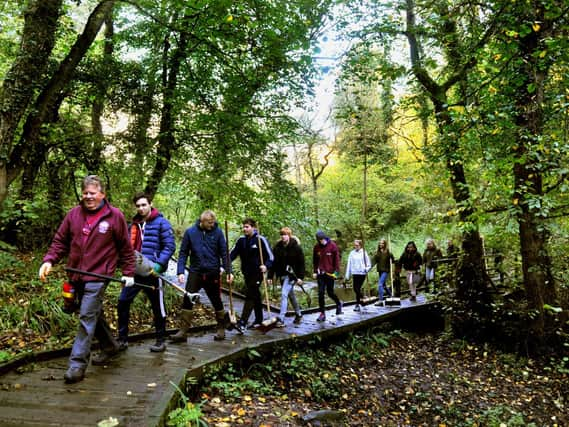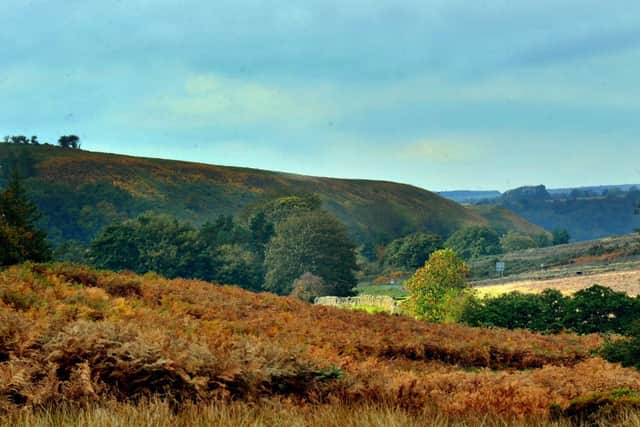North York Moors National Park's value for money to the taxpayer revealed in groundbreaking report


The study published today is described by National Park officials as a “crucial first step” in understanding how they can best measure the true impact on the millions of people every year who interact with them.
University of York academics estimate that for every pound handed over by the Department of Environment, Farming and Rural Affairs (Defra) in grant funding, approximately £7.21 of health and well-being benefits are generated for visitors and volunteers.
Advertisement
Hide AdAdvertisement
Hide Ad

The report’s main conclusions are based on the principle of ‘social return on investment’, a measure of the social value created when organisations offer activities and projects that make a difference to people and society as a whole.
Quantifying such benefits in pounds and pence is far from straightforward. As an example, the health improvements from physical activity by those who visit the National Park are given a value of £6.80, the equivalent cost of a one-off fitness class at a local gym. And the study takes pains to avoid over-estimating the benefits by limiting the analysis to just visitors and volunteers and not school children, teachers or the NHS.
But its findings were welcomed by the Campaign for National Parks, which has backed the restorative power of getting people out into nature and hopes to see this reflected in the recently-announced Government review led by author Julian Glover.
Advertisement
Hide AdAdvertisement
Hide AdChief executive Fiona Howie said: “It is fantastic to see research that clearly sets out what great value for money the North York Moors National Park is in terms of the their impact on people’s health and well-being. And this is even when the figures are almost certainly an under-estimate.
“I hope this helps illustrate to Julian Glover the need for them to recommend increased, multi-year funding for all of the National Parks so they can continue to benefit as many people as possible now and in the future.”
The report identifies specific benefits derived by the hundreds of volunteers in the North York Moors, including expanding social contacts and a sense of satisfaction associated with the increased self-esteem that comes from being involved in worthwhile activities.
And as well as the obvious health benefits to the nearly eight million annual visitors to the park, other “health and well-being impacts” include increased feelings of calmness and happiness and enhanced engagement from finding out more about its special qualities.
Advertisement
Hide AdAdvertisement
Hide AdThe park authority has had its National Park Grant funding from Defra cut in recent years, receiving just £4.235m in the most recent financial year.
Despite this, through its efforts to find other sources of funding from bodies such as the Heritage Lottery Fund and Historic England its annual budget of £9m is its highest ever.
But authority officials say this income has to be concentrated on specific funded projects, putting increased pressure on the parts of the organisation funded by central government.
Advertisement
Hide AdAdvertisement
Hide AdAs well as the need to find new sources of funding there are other issues that could have an impact on the park’s future, including Brexit and the difference it could make to vital farming and land management schemes.
Climate change is a potential threat to the habitats and wildlife in the North York Moors, bringing with it increased erosion of coastal areas and a higher risk of moorland fires.
And policy-makers need to find a delicate balance between enhancing the environment and providing for the housing and employment needs of those who call the park home.
Richard Gunton, director of park services, said the study would “help us advance our ongoing work and our commitment to improving the health and well-being of as many different groups as possible.”
Advertisement
Hide AdAdvertisement
Hide AdJim Bailey, chairman of the North York Moors National Park Authority, said the research “demonstrates the value of what we are contributing towards people’s health and wellbeing, as well as encouraging visitors from all backgrounds to create thriving natural environments.
“I think in our hearts we know that visiting or volunteering in a National Park feels good, and this piece of great work condenses that into a figure we can build upon.
“As always there are challenges that lie ahead, and we look forward to furthering our duties and goals as part of the Government’s current review of national parks.”
A spokeswoman for the Department for Environment, Farming and Rural Affairs said: “National Parks are some of our most precious environments, which is why we have launched a review to ensure these vital landscapes are meeting our needs in the 21st Century.
Advertisement
Hide AdAdvertisement
Hide Ad“We recognise the role National Parks play in improving health and wellbeing, and while we can’t pre-empt the outcomes of the review, we will continue to work closely with National Park authorities to ensure we effectively conserve and enhance these landscapes for future generations.”
Case study
Retired David Bream has carried out some 300 days of volunteering in the North York Moors National Park in the last five years - and he says there is not a single one he has not enjoyed.
The former operations manager at British Sugar acts as a volunteer task day leader, taking volunteers or interested groups out into moors, dales and woods which make up the 550 square mile park.
A recent excursion to Forge Valley, a nature reserve on the banks of the River Derwent teeming with wildlife including otters and crayfish, epitomises his efforts to educate the public about the park’s value.
Advertisement
Hide AdAdvertisement
Hide AdHe took out 24 students from Bishop Burton College in Beverley to help maintain a mile-and-a-half stretch of boardwalk through the reserve, sweeping away leaf debris to stop the timber boards rotting. This work, combined with the replacement of individual boards, will keep the walkway accessible to the public.
“The more you put in, the more you get out”, the father-of-two tells The Yorkshire Post.
“It is really good that you can see people on a path when you are out walking and they thank you because the path is accessible due to what you and your team have done.”
The 64-year-old, who lives in Easingwold, had previously organised the town’s annual fun run but was encouraged to become a park ranger by a fellow volunteer, attracted by the idea of a role he could do week-in, week-our rather than just for a few days a year.
Advertisement
Hide AdAdvertisement
Hide Ad“I do get a lot out of it. If you asked me why I volunteer I would say I don’t know. I think it’s in my DNA,” he says. “Other people spot that and think ‘he won’t say no’ - you know who is going to help.”
The jobs are varied, from brushing and sweeping to building boardwalks or stiles, helping with vegetation clearance as part of flood prevention efforts or monitoring river quality in the River Esk by checking on the local invertebrate population.
On each task he supervises and encourages volunteers to give of their best and see the value in the work they are doing. “I absolutely love it,” he says. “It has got me fitter. I am in awe at the work some of the people here can do. It has got me a lot of contacts.
“I haven’t had a day that I haven’t enjoyed. The day I don’t enjoy it is the day I consider not doing it. I am also very proud to work for a national park. They are a worldwide organisation and it is very much a brotherhood. I enjoy talking to people about the park and educating people about how special it is.”